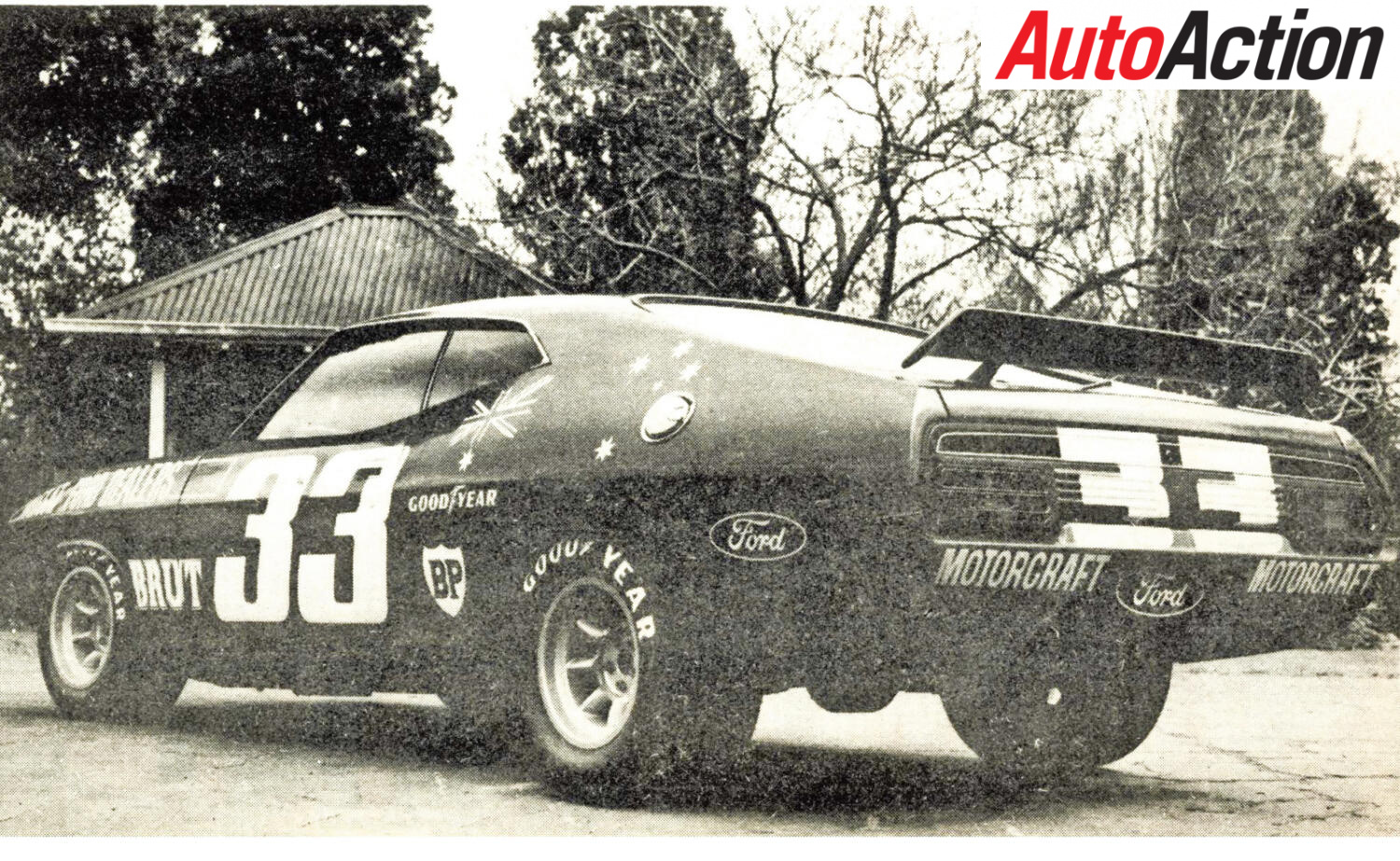50 years ago: Moffat reveals “United Nations” Falcon

Half a century ago excitement was building for the 1974 Hardie Ferodo Bathurst 1000 with Allan Moffat revealing his famous “United Nations” Falcon.
Allan Moffat’s Sandown winning Ford Falcon GT was NOT the car he will run at Bathurst.
The actual Bathurst car was unveiled to a very distinguished gathering at Chaucer’s “chow house” last week, during a very well organised and enjoyable function hosted by BP.
The actual Bathurst car was gathering at Chaucer’s “chow house organised and enjoyable function.
The Falcon, painted the same dark blue as at Sandown, but sporting the Australian flag, and a ‘Moffat Ford Dealers motif along each wing, is pretty much the same as the Sandown car, but was built and developed during an intensive four week period in Ohio USA.
Its engine, fitted with all the newlv homologated Ford parts, is alleged to give around 440 bhp, and unlike the Sandown race car, (but like the car tried during Friday’s unofficial session prior to the 250) it features a four barrel Holly carb, rather than the twin choke Weber setup favoured by the works team last year.

RIVAL
Dieter Glemser has already been nominated as the car’s co-driver, while one time arch rival of Moffat, Horst Kwech, will be relief driver for the pair of them.
Horst is Australian basically, having emigrated to the USA from Sydney in 1962.
He became a pro’ driver in the States, as well as a small car preparation expert there. In 1966, Kwech beat Moffat to the 1600cc sedan class in the amateur racing finals of the SCCA at Riverside.
Subsequently, Moffat and Kwech shared a Mustang at Daytona and Sebring Trans Am races in 1968. On the former occasion the car broke its front suspension while Moffat was driving, although the damage was allegedly sustained during an earlier stint by Kwech.
At Sebring, the car quit while Kwech was driving.
During the rest of the season, Kwech was appointed official Shelby team driver rather than Moffat!
ANTAGONISM
Since that time there has been some antagonism between the two, although this would ap. pear to have been resolved with Horst’s appointment to the driving line-up.
This will be Kwech’s first trip to Australia since he left in the sixties.
Looking after the pits will be Lee Dykstra, an American who was Moffat’s superior during his time as a test driver at Kraft.
Dykstra, along with chassis ace John Mulrine, worked on the development programme of the Falcon in America. Originally a General Motors man, he joined Ford in the mid-sixties, where, at the age of 26, he was involved in the Ford GT 40 pro-gramme, and later in the Trans Am Mustang development pro-gramme.
In 1968 Dykstra headed up the design team on Carroll Shelby’s Mustangs which, as we said earlier, Moffat drove at Daytona and Sebring.
Later he transferred to Kar Kraft. When that part of the Ford empire closed down, he was appointed to research and safety design on Ford passenger vehicles.
CAPRI
Lee Dykstra finally began supervising Horst Kwech’s efforts racing a Capri V6 in the U.S. with the result that he was invited to Cologne to pass on a few of his findings to the European factory racing team.
Married, with three daughters, Dykstra will be in Australia a week before Bathurst, getting things ready for the team’s effort.
The Bathurst Falcon GT will run the modified 5.7-litre V8 developed in Australia by AMR chief mechanic Ray Cutchie.
Power output at 440 brake horsepower is 50 bhp more than the engine in Moffat’s Bathurst-winning works Falcon last year.
RAY CUTCHIE
Part of a 90-day engine development programme by Cut-chie and other engine shop mechanics used information gained from running a 351 V8 in Moffat’s Mustang sports sedan.
A test engine, in Bathurst form, was put in the Mustang for track evaluation at Sandown.
Says Moffat: “The Mustang was set up for sprint conditions and we ran the engine flat out at Sandown. Best lap time was 1:16.0, which is not hanging around.
We were more than happy to set a new record lap of 1-16.9 with this engine in the Falcon at the Sandown 250.
And we were carrying about 36 gallons of fuel at the time. We didn’t have the track to ourselves either.”
OIL SURGE
Two engines were flown to the United States for dynamometer and in-vehicle testing with the emphasis on oil surge problems, durability and reliability.
In the United States the engines were run long and hard – much harder than they will be pushed at Bathurst and for longer than the race distance.
Not in an engine shop, but out on the track where it counts.
The Sandown victory was proof that the homework was right.
Moffat predicts that record times will be set at Bathurst, if weather conditions are right, and says that his Falcon GT should hit 160 miles an hour down Conrod Straight, fastest part of the Bathurst circuit.
During the team’s time in America, two Bathurst rehearsals were run on the 71-mile speed and endurance track at the Transportation and Research Centre in mid-Ohio.
DISNEYLAND
The 10,000-acre centre at East Liberty – it cost $26 million and Moffat describes it as an automotive Disneyland – is used by the Detroit car makers for vehicle testing from Greyhound buses to prototype cars for 1980.
It is the most advanced and newest facility in the world for the study of vehicle behaviour, performance and durability.
Moffat along with Ray Cutchie and electrical wizard Graham “Jackie’
Stewart spent four weeks working there with US engine, suspension and tyre expects developing for the Falcon.
The project was codename Falcon B52.
On both Bathurst trials, the Falcon was run for greater than race distance and was clocked at more than 160 miles an hour rocketing on to the 30-degree banking that links each of the three-mile straightaways.
CRITICAL
The plan was to check the possibility of engine oil surge a critical factor at Bathurst high-speed stability, the Goodyear tyres which were tailor-made for the Falcon.
The car was run on BP Corse 50 oil, which was flown to Ohio from Melbourne.
An interested spectator was all-American champion Mark Donohue, a long-time friend and Trans-Am rival of Moffat, who was testing the new Penske Formula One racer at the centre.
Donohue was invited to drive the Falcon and give his opinion – he is one of the world’s top development drivers. He stayed out on the track so long that he had to be finally black-flagged in!
His comment: That’s a great little car. I was having a ball out there. It sure as hell beats the ‘stockers’ I used to drive.”
SKID PAN
More oil surge and handling tests were done at the centre’s skid pan, which covers an area of 50 acres, has a one-inch fall at the extremities and has nothing to hit.
This is the area which finally determined the range of Goodyear race tyres and compounds which Moffat and co-driver Dieter Glemser will use at Bathurst.
These tyres have been built to the Falcon’s size and weight characteristics with the emphasis on distance but with the grip of a sprint tyre.
Pointing up their staying powers and adhesion was the fact that Moffat only had to replace one front tyre in the recent Sandown 250 shakedown for Bathurst. He also set a new touring car lap record.
Tyres were one of the main factors in the whole expensive operation.
While Moffat was making his last appearance in the 1974 Australian Touring Car Championship that round and the earlier San-down heat in one of the Former Ford works GTs – the Bathurst engine programme headed by Ray Cutchie was getting under-way.
PULLED DOWN
At the same time, an XB model Falcon GT two-door was being pulled down and carefully rebuilt from the ground up by Moffat’s mechanics.
As tyre testing was an important part in producing a Bathurst winner, the decision was made to send the car to the United States.
For obvious reasons testing could be carried out close to the Goodyear factory in Akron, new compounds, mixes and designs could be developed quickly.
Results of tests could be put in the pipeline on the spot and modifications made.
And the finest technical help was readily available.
As well, there was no facility in Australia for duplicating and exceeding Bathurst speeds and conditions.
The Ohio test centre was arranged and the Falcon was flown out in the belly of a Boeing 747.
AIRFREIGHTED
Two of the engines which had been prepared and tested in Melbourne in Moffat’s Mustang sports sedan were later airfreighted to the United States.
The car was given a shakedown run at a short circuit close to Detroit before being sent to Ohio for a proper workеd out.
Moffat also took the opportunity of consulting with Americans car experts on long-distance racing and renewing friendships with suspension and engine designers, including Lee Dykstra.
The car was flown back to Australia, but too late to compete in the Sandown 250.
However, that interim Falcon GT using one of the Bathurst engines and certain refinements from the B52 version was taken to victory at the Melbourne circuit.
This was the story run by AUTO ACTION in issue #95 on October 4 1974.
On the big day things did not go Moffat’s way as the Ford XB Falcon GT Hardtop retired after 92 laps as the underdogs of John Goss and Kevin Bartlett were victorious in another Falcon.
READ THE LATEST ISSUE OF AUTO ACTION HERE
Don’t forget the print edition of Auto Action available via subscription here. For more of the latest motorsport news, subscribe to AUTO ACTION magazine.






